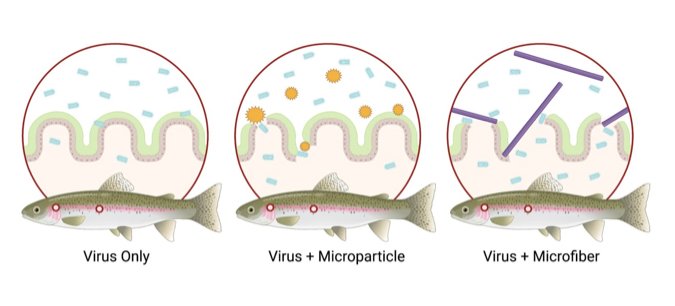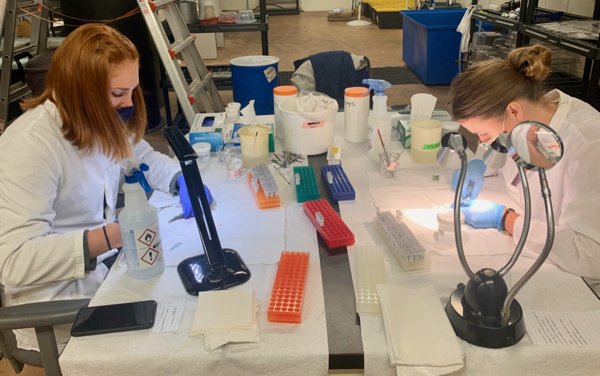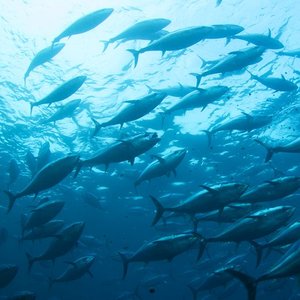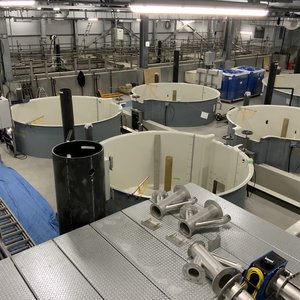A new laboratory study revealed that the presence of microplastics increases the severity of an important viral fish disease. The lead author of the study, published in Science of the Total Environment, Meredith Evans Seeley, conducted the research as part of her Ph.D. program at William & Mary’s Virginia Institute of Marine Science.
“Microplastics and pathogens are everywhere,” said Seeley, “but they’re often present at highest concentrations in densely populated aquatic environments such as fish farms. We wanted to explore if microplastics could affect the severity of IHNV infections in aquaculture.” IHNV is a virulent pathogen in salmonid aquaculture, affecting members of the salmon family including rainbow trout, steelhead trout, chinook salmon, and sockeye salmon.
The team wanted to determine if a “cause-and-effect” may occur between microplastics, viruses, and fish mortality. Seeley and colleagues thus exposed aquarium-kept rainbow trout to low, medium, and high concentrations of three different types of microparticles, and later added the IHN virus to half the tanks. They chose plastics that are both widely used in aquaculture and commonly found as breakdown products in nature: polystyrene foam (often in floats, buoys, home insulation, and food containers); and nylon fibers (lost from fishing nets, fishing lines, and clothing). They also exposed infected and healthy fish to tiny fragments of the common saltmarsh cordgrass Spartina alterniflora. Control tanks held no viruses or microparticles.
“We found that co-exposure to microplastics and virus increased disease severity,” said Seeley, “with nylon fibers having the greatest impact. This is the first time this interaction has been documented and emphasizes the importance of testing multiple stressors, which is more environmentally realistic.”

When exposed to the virus only (blue particles in left-hand panel), the barrier formed by the intact lining of the gill and gut may block some virus from penetrating the tissues. When exposed to small microparticles derived from polystyrene or Spartina marsh grass (orange “suns” in center panel) and then virus, the barrier may be physically damaged, allowing more virus to enter and causing an inflammatory response. Damage appeared to be greatest for nylon microfibers (purple rods in right panel), which are larger and may be more likely to become trapped in and damage the barrier. This may allow greater viral entry and generate stress in the fish, ultimately increasing viral virulence. Credits: Meredith Seeley/VIMS
Based on their laboratory results, the researchers suspect that exposure to microparticles increases disease severity by physically damaging the delicate tissues of the gills and gut lining, thus making it easier for the virus to colonize its host.
Exposure to synthetic microplastics—nylon and polystyrene—had a greater impact than natural microparticles derived from Spartina. Most impactful was exposure to the nylon-derived microfibers. The researchers suspect this may be due to their larger size, extended length, or the greater hardness of the plastic compared to plant matter.
“Nylon microfibers are larger and may be more likely to become trapped in and damage the delicate tissues of the gills and gut lining,” said Seeley. “That could make it easier for the virus to enter and stress the host, ultimately increasing disease virulence.”
The team’s work has major implications beyond fish farming. “Our research question is very relevant in aquaculture,” says Seeley, “but it applies to natural environments as well. Microplastics are distributed worldwide, so at any given time they may be co-occurring with a variety of natural pathogens.”
Reference:
Evans Seeley, M. et al. (2023), Microplastics exacerbate virus-mediated mortality in fish. Science of The Total Environment. https://doi.org/10.1016/j.scitotenv.2022.161191













